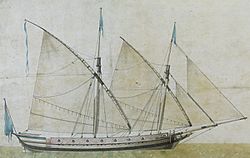Lateen

A lateen (from French latine, meaning "Latin"[1]) or latin-rig is a triangular sail set on a long yard mounted at an angle on the mast. It runs in a fore-and-aft direction.
Dating back to Roman navigation, the lateen became the favorite sail of the Age of Discovery. This was mainly because it allowed a boat to tack "against the wind". It is common in the Mediterranean, the upper Nile River, and the northwestern parts of the Indian Ocean.[2] It is the standard rig for feluccas and dhows. Another form is used on small recreational boats like the Sailfish and Sunfish.[3]
Operation
[change | change source]A square sail is a very simple device. It catches a following wind and pushes the vessel forward.[4] The lateen sail is more complex. It is set at an angle to the wind. It works by creating a difference in air pressure between the two sides (concave and convex) of the sail.[4] This is the same way a fore-and-aft sail works.[4] This is why the lateen sail is considered the ancestor of the fore-and-aft sail.[4] The advantages of the lateen sail is that it is effective in lighter winds. It causes less drag and so is more efficient.[4] It allows the vessel to sail much "closer to the wind" (meaning it can sail at up to about 45 degrees into the wind).[4] This made the lateen sail a very important invention.[4]
Development
[change | change source]
The lateen sail did not directly come from the square sail.[4] There was an intermediate sail type called the lug sail.[4] It was one of the earliest fore-and-aft rigs. It was developed for use on the Indian Ocean.[4] Sailors knew that the wind does not always come from behind the vessel. They learned that the square sail could be made more efficient by turning it on the mast so it remained at a right angle to the wind.[4] When used with a keel and some form of steering, it provided more options. Instead of simply sailing downwind, the vessel could move in different directions relative to the direction of the wind.[4] If the wind came from the beam (side of the ship), rotating the sail became less effective.[4] But, if the luff (edge of the sail) was pointed into the wind and kept taut, the sail would provide forward movement.[4] This could be made more effective if the yard (or spar) holding the sail is sloped downward into the wind.[4] From this discovery came the lug, then the lateen.
History
[change | change source]
In ancient history the square sail was used in the Mediterranean.[5] It was used on seagoing ships of the Phoenicians, Egyptians, Greeks and Romans. In Northern Europe at this time, they only used the square sail. This was even after the ships in the Mediterranean were using the triangular lateen sails.
The 15th and 16th century caravel was a favorite type of ship used in the Portuguese and Spanish voyages of discovery.[6] In addition to their distinctive single sterncastle, they carried lateen sails.[6] During this time the caravel developed into a very fast and highly maneuverable ship.[6] Two of Christopher Columbus's ships, the Niña and the Pinta were caravels. He repeatedly praised the Niña as his fastest and favorite ship.[6]
References
[change | change source]- ↑ "lateen". Dictionary.com. Retrieved January 2, 2017.
- ↑ A. Ansted, A Dictionary of Sea Terms (London: Gill, 1898), p. 232
- ↑ staff, 'On the Racing Circuit', Motor Boating, (May 1964), p. 168
- ↑ 4.00 4.01 4.02 4.03 4.04 4.05 4.06 4.07 4.08 4.09 4.10 4.11 4.12 4.13 4.14 I.C. Campbell, 'The Lateen Sail in World History', Journal of World History, Vol. 6, No. 1 (1995), pp. 1–2
- ↑ "Ancient Sailing and Navigation". Nabataea.net. Retrieved January 2, 2017.
- ↑ 6.0 6.1 6.2 6.3 "History of the Caravel". Nautical Archaeology at Texas A&M University. Archived from the original on May 6, 2015. Retrieved January 2, 2017.
